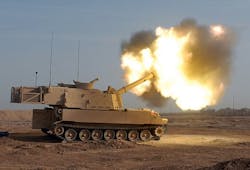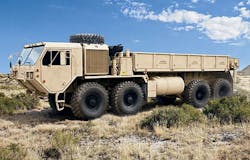Pentagon to hike spending for armored combat vehicles procurement and research by 18.6 percent
The U.S. Department of Defense (DOD) fiscal 2018 budget request to Congress proposes $4.5 billion for combat vehicle procurement and research, which is up 18.6 percent from 2017 levels of $3.8 billion for the same programs, which include the:
-- Joint Light Tactical Vehicle (JLTV);
-- Army Armored Multi-Purpose Vehicle (AMPV);
-- Army Family of Heavy Tactical Vehicles (FHTV); -- Army M1 Abrams main battle tank;
-- Army Paladin Integrated Management (PIM);
-- Army Family of Medium Tactical Vehicles (FMTV);
-- Army Stryker; and
-- Marine Corps Amphibious Combat Vehicle (ACV).
Of all these armored combat vehicle programs, the big winner in the 2018 DOD budget, surprisingly, is the Army M1 Abrams tank from General Dynamics Land Systems in Sterling Heights, Mich. The M1 Abrams has been in service for 37 years, and DOD is asking Congress for $1.2 billion next year to upgrade this battlefield behemoth, which has been in service since 1980. This represents a 35.1 percent increase from 2017 M1 Abrams spending of $898.7 million.
For next year Army leaders want to spend $1.1 billion in procurement and $198.6 million in research for M1 Abrams tank upgrades, which include adding space, weight, power, and protection against improvised explosive devices (IEDs). Other planned Abrams tank improvements include sensor upgrades and the convergence of several tank round capabilities into a multi-purpose round.
The Army next year also plans to upgrade 56 legacy M1A1 tanks to the M1A3 SEP v3 variant, and proceeding with M1 upgrades that include adding the:
-- Ammunition Data Link (ADL) to enabling firing the Army's new smart 120-millimeter ammunition;
-- low-profile Commander's Remote Operating weapon Station (CROWS); and
-- Active Protection System.
Another big winner in the 2018 combat vehicle budget is the Joint Light Tactical Vehicle for the Army and Marine Corps. DOD is budgeting $1.1 billion next year to buy 2,777 JLTVs from prime contractor Oshkosh Defense in Oshkosh, Wis. This is a 47.3 percent increase from 2017 levels of $775.8 million.
Related: Army makes quarter-billion-dollar JLTV armored combat vehicle order to Oshkosh Defense
Other JLTV research and procurement money in 2018 will pay for full-up system level testing, multi-service operational test and evaluation, JLTV automatic fire extinguishing system test, and command, control, communications, computers, intelligence, surveillance, and reconnaissance (C4ISR) testing.
The PIM program seeks to address weight and power concerns in the Paladin and FAASV combat vehicles, end ensures sustainment of the M109 family of artillery vehicles through 2050. It replaces the current Paladin and FAASV with a more robust platform that incorporates the M2 Bradley Fighting Vehicle common drive train and suspension. 2018 funding also will pay for 71 new PIM artillery systems. The PIM contractor is the BAE Systems Platforms and Services segment in York, Pa.
The Army's Armored Multi-Purpose Vehicle (AMPV) program to replace the M113 armored personnel carrier is budgeted at $674.4 million next year, which is more than triple 2017 AMPV funding levels of $184.2 million.
The AMPV will have five mission roles: general purpose, medical treatment, medical evacuation, mortar carrier, and mission command. The program integrates the current M113 mission equipment package onto a new Bradley Fighting Vehicle chassis to enable Army brigade combat teams to move quickly on the battlefield.
The Marine Corps future Amphibious Combat Vehicle (ACV) will see a major increase in research funding next year, as the 2018 DOD budget contains $340.5 million for this program -- more than double 2017 funding levels of $158.7 million.
The ACV program will replace the Marine Corps ageing Amphibious Assault Vehicle, and will provide an armored personnel carrier that can swim through the ocean and drive onto assault beaches. Fiscal 2018 funding would pay for building 26 ACVs and four ACV test vehicles. The builder is BAE Systems Platforms and Services.
The Army Family of Heavy Tactical Vehicles (FHTV) program, which consists of the Heavy Expanded Mobility Tactical Truck (HEMTT) and Palletized Load System (PLS) from Oshkosh Defense, is set to receive $118 million next year, more than double 2017 funding of $57.1 million.
The Army plans to buy 621 FHTV vehicles next year, as well as trailers to modernize the heavy tactical vehicles fleet for Army, National Guard, and Reserve units.
Related: Army orders 100 FMTV military trucks with integrated vetronics on SAE digital databuses
The 2018 budget has $84.7 million to pay for 37 new trucks, which is down 76 percent from 2017 levels of $352.8 million for 1,252 new trucks this year. The FMTV builder is Oshkosh Defense.
Also set for a funding cut is the Army's Stryker family of armored vehicles, which has a 2018 budget of $178.2 million -- down nearly 76 percent from 2017 levels of $735.5 million. Stryker is a 19-ton air-deployable wheeled armored vehicle for reconnaissance, anti-tank missile, medical evacuation, fire support, mortar carrier, and command missions.
The vehicle has been in service since 2002. Funding for 2018 would pay for lethality upgrades, general modernization, and fleetwide upgrades to the Stryker's C4ISR systems, adding a 30-millimeter weapon, and obsolescence mitigation. The Stryker builder is General Dynamics Land Systems.
Learn more: search the Aerospace & Defense Buyer's Guide for companies, new products, press releases, and videos


